|
If you’re British and of a certain age, a title like Bruiser has specific connotations. In the UK, at least, it’s a word that was once – and maybe still is – used to describe an aggressive, usually male individual who enjoys getting into fights. Throw in the fact that the film in question was directed by horrormeister George Romero between his 1993 adaptation of Stephen King’s The Dark Half and the fourth film in his genre-defining zombie movie series, Land of the Dead (2005), and you’ll likely have another series of expectations entirely, which may then be thrown into turmoil by the blank white facemask that dominates posters for the film, and indeed the cover of this new Indicator UHD. So who, or what, is the bruiser of the title? Whatever your expectations, you’re likely to be caught out by the answer. I certainly was.
The film begins with a montage of cutaway closeups, as a man whose face initially not shown switches off his morning alarm and completes what is doubtless a morning ritual by showering, drying his hair, brushing his teeth, shaving, and pumping out press-ups, all to the tune of a radio phone-in show on which a caller is talking about taking his own life and not being taken seriously by the cynical host. As the caller outlines the reasons for his despair, the man in the bathroom wipes the mirror and we finally see the face of 30-something Henry Creedlow (Jason Flemyng), who then raises a pistol, plants it firmly under his chin, and blows out his brains. The film then cuts back unexpectedly to the shot of Henry wiping the condensation from the mirror, but this time there’s no gun and no suicide. Instead, Henry stares at his reflection with an expression that suggests he shares the show caller’s distress at the idea that despite shovelling shit all his life, he will ultimately leave no mark on the world. “It’s like you shouldn’t ever bother,” the man tells the now more sympathetic host, “It’s like you’ve never been here at all!” The host attempts to convince him otherwise but is cut suddenly short by the sound of a gunshot. Every bit of this proves to be highly significant to the story that subsequently unfolds.
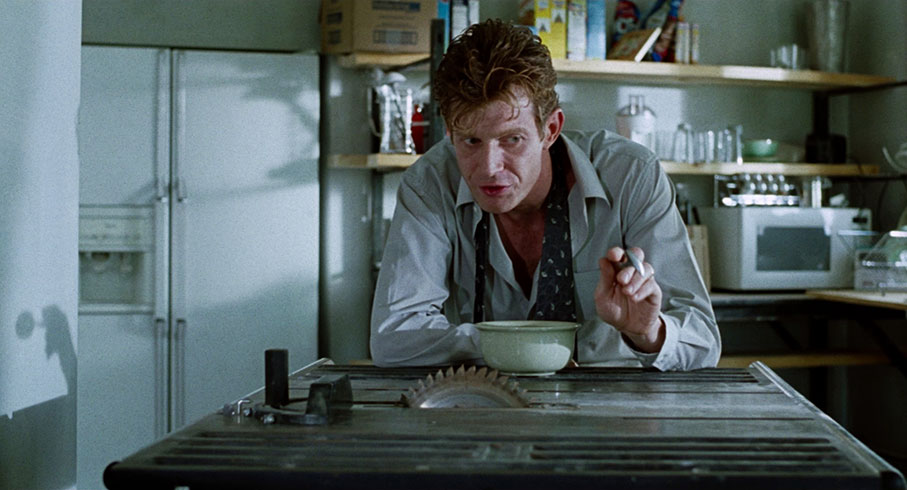
Henry then returns to the bedroom and gently attempts to wake his wife, Janine (Nina Garbiras), but she just wants him to close the curtains so she can go back to sleep. Henry complies, and as he exits the bedroom through a wall of plastic sheeting, we become aware that the house is an as-yet unfinished project whose completion we soon Henry is struggling to find the money to pay for. As he pours himself a bowl of cereal, he’s joined in the half-finished kitchen by Janine’s ghastly pet poodle, which has somehow learned the trick of hitting the floor switch to activate the circular bench saw on which the startled Henry is using as a breakfast table. Although this does feel like the foreshadowing it later proves to be, things do not play out as I predicted and perhaps even feared they might.
As Henry, in a sober suit and carrying a briefcase, heads off to the railway station on foot, he’s picked up by his old friend and colleague Jimmy (Andrew Tarbet) in his brand new black Mercedes. “I tell ya, Henry,” Jimmy tells him as they drive away, “if I could fuck a car, I’d never leave my garage,” then accelerates so rapidly that it has Henry shrinking in his seat in fear. If that wasn’t enough, when they reach the station, Jimmy confirms his status as a self-centred yuppie by parking his car diagonally across two parking spaces. What a douche. As the two men discuss investments on the platform, I became convinced that they must be stock traders or employed in some other socially pointless role in corporate finance. Either way, Henry’s not getting the return on his investment that he hoped for and needed. “I expected it to be more,” he says in disappointment as Jimmy shakes his head in amusement and suppresses a mocking grin, “I always expect it to be more.”
When the train arrives, a woman rudely shoves Henry aside to board before him, and he reacts by furiously pulling her to the ground, punching her out cold, and placing her head on the tracks, where it is quickly crushed by the wheels of the now moving train. And suddenly, we’re back in reality with a lost and confused Henry standing alone on the platform in front of the open doorway of the still stationary carriage. As the train starts to pull away, Henry snaps out of his daze and boards it, disturbed by the vivid vision he has just experienced. Clearly there’s a Billy Liar element to Henry’s personality, albeit one driven by violent thoughts over which he appears to have little control.
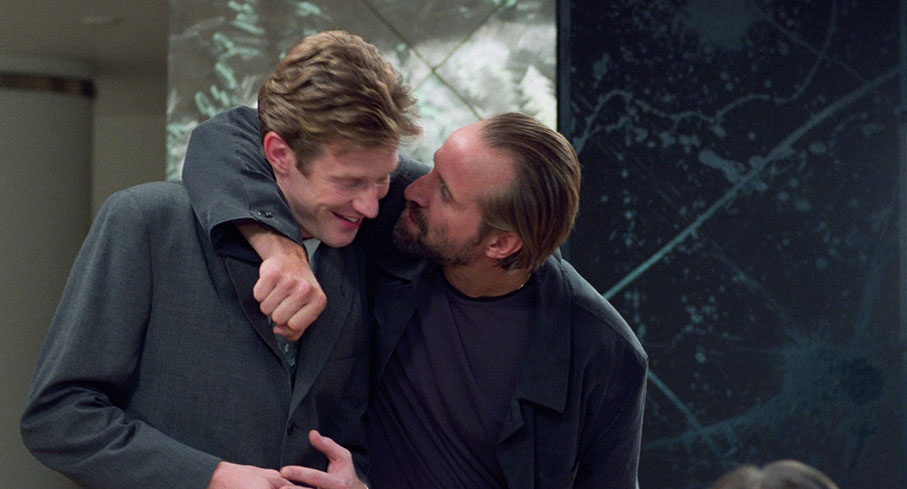
It's when Henry arrives at his workplace that we finally get an explanation for the film’s enigmatic title. Well, sort of. It turns out that Bruiser is the name of a successful fashion magazine at which Henry is one of the creative directors who have today been charged with selecting the face for the cover of the magazine’s September issue.* Henry’s iffy social skills see him fail to engage any of his distracted colleagues in conversation, at least until he bumps into Tom Burtram (Jeff Monahan), with whom he appears to have a better rapport. It turns out that he’s on equally friendly terms with Rosie (Leslie Hope), the ex-wife of Bruiser owner Miles Styles (Peter Stormare) who is now employed by him as a magazine photographer and who instantly stands out as the only one present not dressed in a manner that feels glumly corporate compliant.
It’s then that Miles himself explodes into the room, and for some this will be where the film hits its first divisive hiccup. Up to this point, even the more annoying characters have had a believably naturalistic leaning, but it proves to be a very different story with Miles, who is quickly established as a coked-up, narcissistic and racist egomaniac who exerts a vice-like grip on his put-upon employees through a combination of verbal bullying and public humiliation. After he curtly dismisses each of the proposed cover faces in turn, it briefly looks as if the one that Henry has picked on Rosie’s cautious suggestion might finally earn him a nod of approval from his overbearing boss. Instead it results in what is clearly the latest of a long run of laughingly mocking put-downs and physical manhandling, which Henry takes with the sort of fake smile that you wear when desperately trying to hide your embarrassment and resentment from others. Despite this, for some reason Milo has put Henry in charge of organising a party for the Bruiser employees at Rosie’s house this coming weekend, enquiries about the progress of which give him the chance to loudly belittle Henry even more.
Quite how someone as clearly decent and down-to-earth as Rosie ended up ever being married to an egomaniac like Miles is anybody’s guess, and at the party it becomes clear that she has far more in common with Henry than she does with her dreadful ex. While Miles wanders around the garden making disparaging remarks and pushing guests into the pool, Rosie indulges in her hobby of making life casts of the faces of the guests, which she then encourages their owners to paint in a manner that expresses their personality. When Henry has his turn, however, he ends up sitting alone staring at the blank white mask and unable to think of a way to appropriately decorate it. This, once again, will strongly resonate later. He thus heads back to the party, but stops short just in time to see the pushy Milo getting a sneaky hand job from compliant Janine. This encounter becomes the trigger for an argument between Henry and Janine on their journey home, with Janine angrily berating Henry for his failings as a husband and a financial provider. When they reach the house, Janine orders Henry out of the car and tells him not to wait up, then barrels the car into the garage in what looks like an attempt to run him down. Already seething, he quickly reacts by grabbing an axe from the wall and furiously smashing it through the windscreen and into Janine’s head, and for the third time I was fooled into thinking that one of Henry’s angry fantasies was real. As we snap back to reality, Janine makes good on her promise and drives off into the night, and the defeated Henry grabs a drink and eventually settles down to sleep. The following morning, the montage that opened the film is repeated in compressed form, but when Henry wipes the mirror, he is horrified to discover that his face has been replaced by the white mask from Rosie’s party, and that it appears to have organically bonded with his skin.

Part of the strength of much of the best horror of the past half-century or more has been its sometimes potent allegorical substructure, and few, if any, have so effectively woven this aspect into the narratives of their genre films than George A. Romero. The thing is, you don’t have to be directly aware of this element to appreciate and respond to these films as horror tales, yet often what gives them their distinctive impact and makes their stories and characters relatable is that the fantastical horror is informed by relatable real-world situations and issues. As a result, many viewers respond to a socio-political subtext without even realising that the film even has one. In Bruiser, however, a key aspect of that subtext has been moved so closely to the surface that it almost becomes the text, as Henry becomes the physical embodiment of the faceless and identity-stripped man he believes he has become. And this proves to be much more than a cosmetic change, as his new anonymity awakens in him the confidence to confront and take action – violent action – against those who have repeatedly belittled him and exploited his meek and subservient nature. In the wrong hands this would play as unsubtly clunky, but in Bruiser it’s something that Romero and his cast somehow sell as strangely but captivatingly plausible, with the result that we become emotionally involved in Henry’s fate.
Before I get to the film’s strengths, there are a couple of issues I need to address. The first is one that is in no way specific to Bruiser but is endemic to revenge-themed movies as a whole, and that’s the notion that every crime against the initially victimised protagonist, however small, is seemed punishable by execution without trial, usually through excessively violent means. It probably doesn’t help that the first two people that Henry kills are women for the non-capital crimes of theft and adultery. And while a gender balance is restored by the two deaths that follow, the only two people that Henry fantasises about killing are also women, both of whose deaths are gruesomely visualised. Of course (and there are spoilers ahead, so skip to the next paragraph to avoid), from the moment Henry embarks on his vengeful murder spree, the one person we absolutely know he will ultimately and probably climactically target is the awful Miles, a character that most will likely look forward to seeing spectacularly dispatched. Yet when the moment comes, the cathartic sense of satisfaction that it should deliver is muted somewhat by the credibility-stretching nature of the tool of execution and the questionable ease with which Miles is led to his demise. How you feel about the climactic nightclub scene as a whole – which draws on a range of possibly unconcious influences from The Phantom of the Opera to Les enfants du paradis (1945) – may depend on your fondness for those 80s movies that made happy bedfellows of horror and rock ‘n’ roll, often showcasing the music of a specific rock combo, which in this case is horror punk pioneers The Misfits.
Yet what makes the film so fascinating, in spite of these small quibbles, is as much down to Romero’s texturing of scenes and gameplaying with audience perception and expectations as his ever-evident skill as a director of actors and camera. As I noted above, I was initially fooled into believing that Henry really had killed Janine with an axe in their garage, despite this being the third such violent fantasy. This is then most effectively flipped around when the newly faceless Henry confronts his South American maid Katie (Beatriz Pizano) about the goods and money she has been stealing from him for some time. As he swings her bag of stolen silver at her so violently that in launches her over the couch and leaves her lying apparently lifeless on the floor, I was initially convinced it was another one of his fantasies. Only when the scene continues without the expected reset did I realise that this time the murder was for real. Every bit as surprised by that fact is the startled Henry, who then acts on panic-driven impulse when he hears Janine’s car pull up outside, righting the couch, covering bloodstains, and wrapping Katie’s body in decorator’s plastic sheeting, which he then drags it to a secluded corner to hide. Here Romero uses the risk of possible discovery to build real tension, as we sweat for Henry as that bloody poodle nearly gives the game away, whilst being simultaneously reminded of the awful nature of Henry’s crime by the death twitches of the woman he has inadvertently killed. The fact that I really felt for Katie at the same time as I was hoping that her grim final moments would not alert Janine created a conflict of emotions in me that I’ve yet to comfortably resolve. If the very public second execution that follows risks tipping Henry into psychopathy, some balance is restored by a potential victim that he frees on trust, and a third killing that may well have been planned as a murder but ends up being an act of instinctive self-defence.
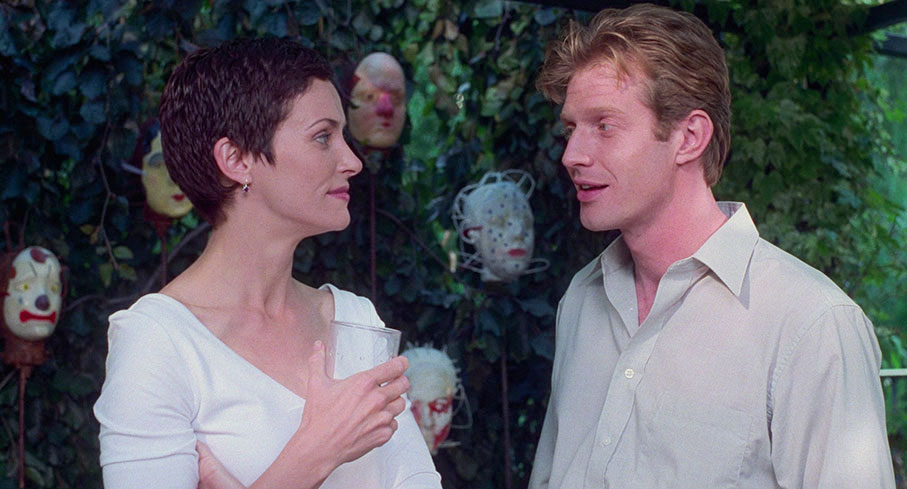
Romero himself has acknowledged the influence of Georges Franju’s haunting 1960 Eyes Without a Face [Les yeux sans visage] on the look and the personality-blanking effect of Henry’s facemask, and despite producer Peter Grunwald's adamant claim to the contrary, there is also a small whiff here of Sam Raimi’s 1990 Darkman, whose faceless revenger ultimately ends up as another anonymous figure in the crowd. As the film’s sole scriptwriter, Romero has a real ear for smart, creative and yet believable dialogue, never lazily falling back on stock lines when he can gift his characters interesting things to say, and also shines as a director of actors, in which capacity he is well served by his well-chosen cast. That we so easily bond with Henry at an early stage is down in no small part to how sympathetically he is played in the early scenes by Jason Flemyng, who nails his American accent so convincingly that I genuinely forgot that he hails from South London. His distinctively angular features and expressive face and body language also prove essential to communicating Henry’s emotional state once his eyes disappear behind a mask that also constricts his facial muscles, robbing him of two of the film actor’s most essential tools. Andrew Tarbet plays Jimmy with just the right degree of smarmy self-satisfaction, and I really liked Leslie Hope’s performance as Miles’ long-suffering ex-wife Rosie. Her friendship with Henry feels genuine from the off, and the two feel so perfectly matched that I ached for them both to just abandon their current lives and find a new life together somewhere far away from corporate America. Entering the story after the very public second killing are Detectives Rakowski and McCleary, engagingly played by Jonathan Higgins and John Carpenter favourite Tom Atkins (who previously worked with Romero on the 1990 Two Evil Eyes), and as the one person at Bruiser magazine apart from Rosie that Henry seems to have a genuine bond with, Jeff Monahan brings warmth to the relatively small role of Tom Burtram. And then there’s Peter Stormare, whose wild and almost uncontrolled performance as Miles is in complete contrast to the relatively low-key work being done elsewhere, and the polar opposite of his taciturn killer in the Coen brothers’ Fargo four years earlier. There’s almost a sense at times that Romero didn’t so much direct Stormare as prime him up and unleash him, then refusing to reign him in no matter how far he pushed the emotional envelope, an opportunity that Stormare responds to with unabandoned enthusiasm. For some – including one of the otherwise positive contributors to the special features on this disc – it’s a wildly overacted and misjudged distraction from the unfolding drama, and while I’m sympathetic to this viewpoint, I know from unpleasant experience that Miles is not the wild exaggeration that he may initially seem. Indeed, if you’ve ever worked in the media, and especially in advertising, music or fashion, there’s a good chance his theatrically bombastic powerplays and desperate need to control every situation in which he finds himself will have a horribly familiar ring.
Given that Romero himself has been open about the film’s allegorical status, exactly what Henry and his subsequent faceless persona ultimately represent is open to a range of possible interpretations. Is this, as many have surmised, a film about how individuals are forced to surrender their identity and creativity when they become a cog in the corporate capitalist machine? Is Henry’s faceless persona a physical manifestation of the id let loose by an emotionally battered ego? Is the mask, as Romero claims, merely a figment of Henry’s troubled imagination, and if so, is what unfolds a portrait of a serial killer (named Henry, no less – take note, future filmmaker John McNaughton), where characters are presented not as they really are but as they appear to the mentally tortured and troubled Henry? Could the fact that Henry only acts on his violent impulses when his face is hidden be a comment on those keyboard warriors who write hateful comments and incite others to violence but hide their own identity behind a mask of internet anonymity? And if the mask is all in Henry’s mind, has he created it to unconsciously distance himself from actions that he knows deep down are ultimately wrong? I had to stop myself here, as I have a feeling I was just getting started here. Feel free to add your own interpretation to the list.
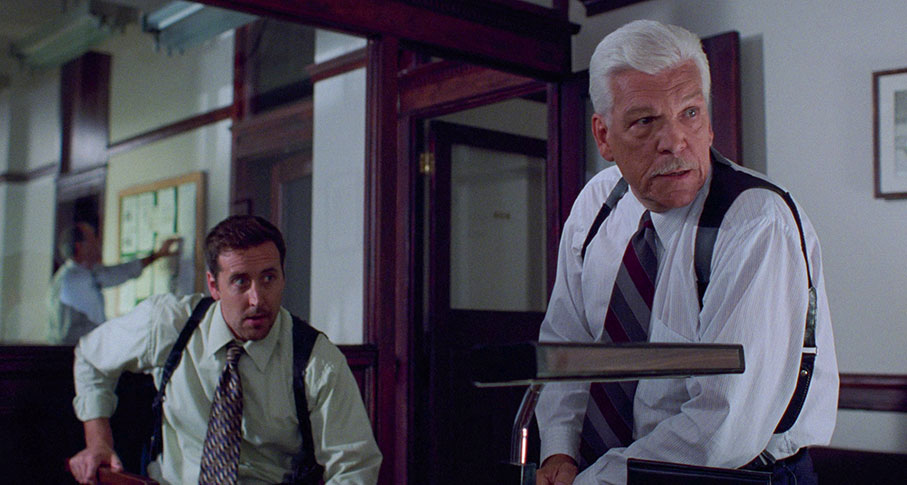
Despite my ever-growing enthusiasm for Bruiser, I’m not to claim that it’s top-tier George Romero, but that’s only because Romero set the bar so high with the original Dead trilogy, The Crazies (1973), Martin (1977), Creepshow (1982) and even the criminally undervalued Knightriders (1981). Yet in the post-Creepshow period of his career, Bruiser may well be his most oft-overlooked and underappreciated work. Despite being less well-known and discussed, it deserves to stand alongside the likes of Monkey Shines (1988), The Dark Half (1993) and – dammit – Land of the Dead (2005), flawed films that nonetheless still stand head and shoulders above so many of their often formulaic genre contemporaries of the day. Bruiser may wear its central metaphor on its sleeve and be structured as a traditional worm-turns revenge drama with all the morality issues that come with that subgenre, and it may lose its focus a little in the climactic scene, but it still makes for dramatically arresting and allegorically provocative viewing. The shift from the rapidly cut static shots of Romero’s earlier films to the longer takes and fluid camera moves of his late career period is on full display here, as is the confidence and control he seems to bring out in his actors. Yes, he makes an exception for the explosive Stormare, just as he did with Joe Pilato in Day of the Dead (and, of course, Luc Besson did with Gary Oldman in Léon), but for my money this works for a character who just would not feel egocentrically monstrous if performed with more restraint. Not a game-changer, perhaps, and not everything completely clicks, but Bruiser is still a consistently well written, well made and impressively performed work, and in common with so many of Romero’s films, it takes a fresh, often original and intelligently layered approach to familiar tropes, and does so in engrossing, socio-politically infused and sometimes surprising ways.
Right, I have to be careful how I word this as I don’t want to give the wrong impression. With this release I’ve been fortunate enough to have been sent both the Blu-ray and UHD review discs, enabling me to make a direct comparison. And while the image quality on the Blu-ray is terrific, the 4K UHD transfer takes it to a different level, less due to the expected resolution bump (although that’s definitely visible) than the often gorgeous Dolby Vision HDR grading. Seriously, there are scenes where the difference is quite striking, notably in the opening shot of the party at Rosie’s, which on the Blu-ray initially appears to be taking place late afternoon, while on the UHD it looks more like the twilight of early evening. The difference is further enhanced by a noticeably wider contrast range on the UHD, with shadows that have real depth and detail, and an even more vibrant and almost tactile colour palette. The transfers on both discs are free of damage and wear and are stable in frame, and a fine film grain is visible, though even this has a more cinematic feel on the UHD. Don’t get me wrong. The Blu-ray is absolutely top-notch for the format, but the UHD is a testament to the difference that a great Dolby Vision HDR colour grade can make. If you only have the facilities to play Blu-ray discs you won’t be disappointed, but if you are UHD ready, that disc is absolutely the one to go for (for technical reasons, the grabs included here are from the Blu-ray).
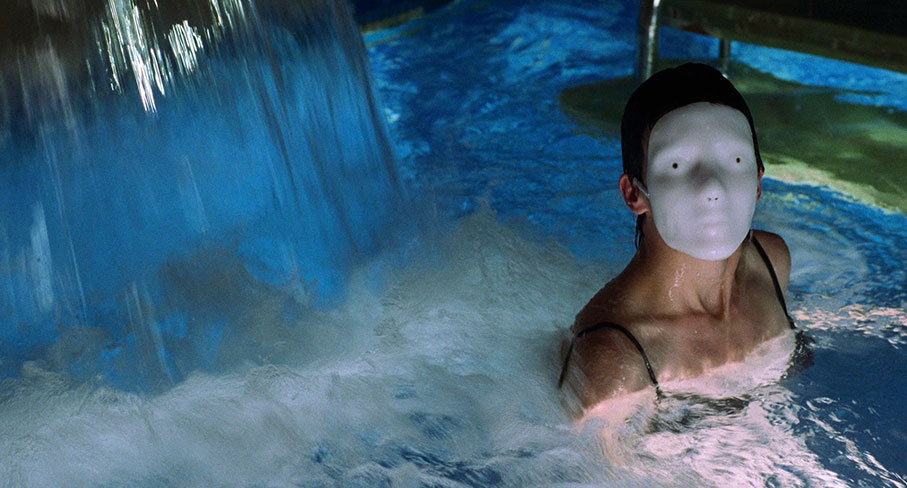
The DTS-HD Master Audio 2.0 stereo track is in robust shape on both discs, with a strong tonal range and excellent clarity, with the Misfits’ music in the climactic nightclub scene really delivering a kick without a hint of distortion. This is also a true stereo mix, with directionally located sound effects and subtle separation on the music and ambient sound, and there’s not a trace of wear or damage anywhere.
Optional English subtitles for the hearing impaired are available.
Audio commentary with George Romero and Peter Grunwald
Originally recorded for a 2001 US DVD from Lion’s Gate, this commentary with director George Romero and producer Peter Grunwald, who worked together on every Romero film from Monkey Shines onwards, is the essential companion to this film. A mix of background information, anecdotes from the shoot, and reflective opinion, it’s an equally informative and entertaining listen, akin to hanging around with two good friends as they recall a particularly enjoyable time spent working together. Indeed, Romero claims at one point that this is his only film that had no ugly moments in its making and that he would ahappily live every moment of it again. He also reveals that, apart from Martin, the finished work was the closest to his original intentions of all the films he has made. Both men praise the crew, the great sense of humour of the cast, and the largely hands-off approach of project funder Canal+, and reveal that the first killing (a long and complex scene) had to be reshot when a new look for the mask was decided on early in the production. Some interesting details are provided on the locations used, which include Romero’s willingness to rewrite a scene to accommodate the contents and features of the properties in question, and the fact that the owners of the Creedlow house were living in the basement while the film was being shot. They confirm that Peter Stormare would continually improvise, which at one point meant having to quickly write and cast a character that he invented on the fly to have someone to shout at, and there’s even a chat about the cars that Romero uses in his films. There’s so much more of real interest here. The only minor niggle for this tinnitus-afflicted listener is the audio mx, which has the soundtrack to the film playing underneath the commentary, but a little too loudly, which almost drowns both men out when The Misfits are playing during the nightclub climax. I have little doubt that Indicator were supplied with the commentary mix as is, so that’s not something that could adjusted so long after it was recorded stage.
Archival Interview with George A Romero (43:42)
Conducted by James Blackford on 8 November 2013 and recorded for archival purposes rather than broadcast (there’s the usual captioned warning about the quality at the start, but it’s generally fine), this audio-only interview with George Romero is an absolute treat for fans of the filmmaker’s work. Blackford is clearly an admirer but also asks well-targeted questions and makes consistently pertinent points, to which Romero always has detailed and interesting responses. Areas covered include Romero’s journey from a young film devotee to making Night of the Living Dead (1968), what Blackford sees as ‘the Romero style’ of his early work, the political subtext evident in his genre films, the intense use of gore in the later zombie movies, and so much more. The director cites Martin and Knightriders as his two favourite and most personal films, outlines a few of the projects he began work on with Stephen King that never came to fruition, admits that smaller productions are generally more enjoyable to work on, describes Orion as a terrible studio that made all the wrong decisions (they famously hated and wanted to bury both Dances with Wolves and The Silence of the Lambs, both of which went on to be enormous hits), and suggests that there was no need for a bloated zombie film like World War Z (2013). In a comment that is especially relevant to this release, he admits that there was a change in his style that came with working with union crews, bigger budgets and stricter schedules, and adds that the first time he did this was any success was with Bruiser. A terrific inclusion.
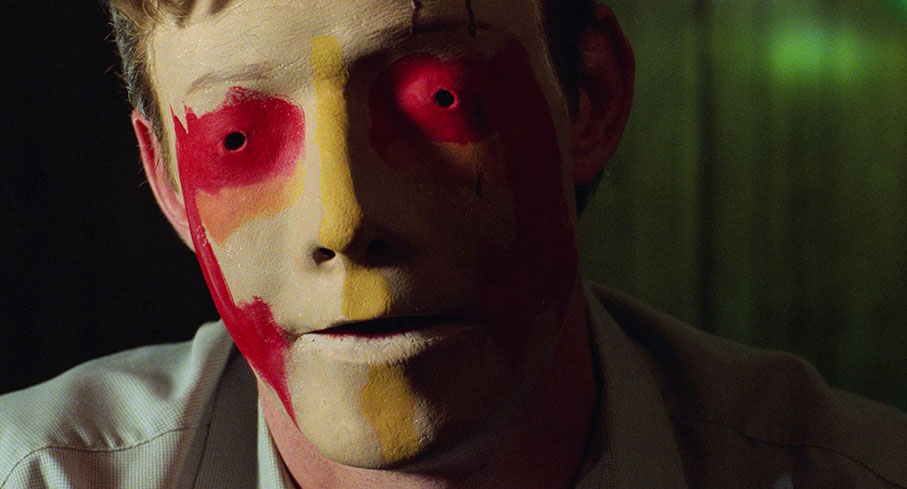
Jason Flemyng: Behind the Mask (9:26)
A welcome chat with the film’s London-born leading man, Jason Flemyng, who is rather sweetly self-depreciating about the reason for his casting, and admits to jumping at the chance to shoot a film in Canada, to get well paid for it, and particularly to work with George Romero, whom he impersonates to express how enthusiastically the director responded to even the smallest thing he did. He talks briefly but revealingly about the white mask make-up (it extended into his mouth and severely restricted what he could eat), and is proud of the film and wishes it had done more for Romero’s career. What he does make clear is the joy of filmmaking that Romero brought to the set and the freedom that he gave to his actors, and although initially disappointed with aspects of his performance when he saw the finished work, he admits to warming to it more over time.
Dr.Chud: A Perfect Fit (8:59)
Drummer for the rock group The Misfits, Dr.Chud (and yes, that’s exactly how it’s written, without a space after “Dr.”) recalls his joy at performing in a George Romero film and writing its songs with his bandmates, tunes that he happily describes as “brilliant.” There are some interesting anecdotes here, including the revelation that he wrote some score music for the film in his own time without Romero’s knowledge, only to then repeatedly shy away from giving it to Romero to listen to (we get to hear some of it, and it’s pretty good). He still has a prop he stole from the set as a keepsake after filming was complete, as well as a poster he found for Night of the Living Dead that he asked Romero to sign, only for the director to reveal that it was a rare original. He also talks about the music video for the Misfits song Scream!, which Romero directed.
Kim Newman: The Worm That Turned (11:44)
Venerable critic and author Kim Newman must be on call for whenever an independent label puts out a genre Blu-ray in the UK. I’ve no problem with that, as he really knows his stuff, and is back again here to talk about what he fairly describes as Romero’s least known and seen film, except perhaps for the 1971 There’s Always Vanilla. The title given to this piece is inspired by what Newman calls the Turning Worm Horror Film subgenre, other examples of which he cites, as well as examining Bruiser in the context of the director’s filmography. He notes that when it comes to the character of Miles, no-one writes awful people better than Romero, or gives the actors who play them more freedom to really push the envelope. When it comes to whether the mask is real or a figment of Henry’s imagination, he kicks against Romero’s opinion that it’s the latter, opining that he doesn’t care about the supernatural reason for it happening, he just needs to be real. I’m kind of with him on that.
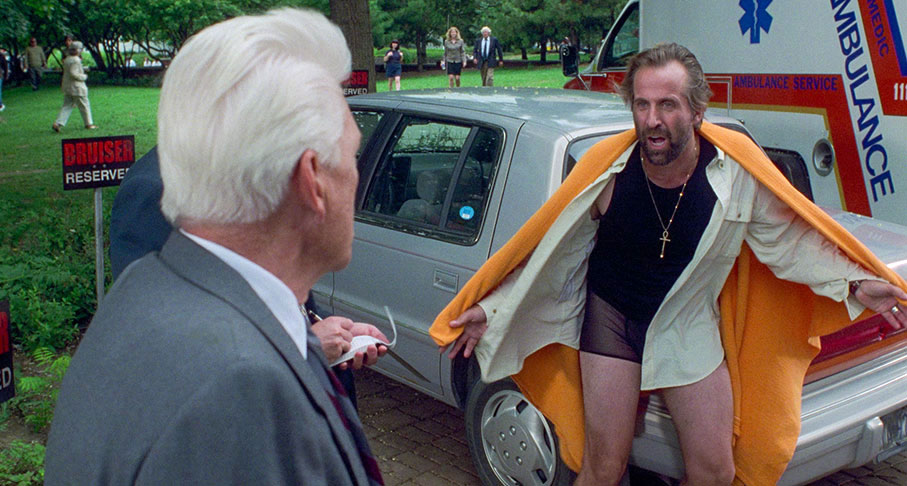
Introduction by Jean-Baptiste Thoret (10:15)
French filmmaker and critic Jean-Baptiste Thoret delivers a passionate and lightning-fast appreciation of Bruiser, which he describes as “one of the most infamous and least appreciated films of its time.” Least appreciated, sure, but infamous? I’d have liked to see that comment elaborated on. That small query aide, Thoret is absolutely on the ball here, outlining the influence of Georges Franju’s Eyes Without a Face, providing a concise overview of the careers of George Romero, Peter Stormare and Jason Flemyng, and even discussing some of the films directed by Jason’s father Gordon Flemyng, his favourite being the 1966 Dr. Who movie, Daleks' Invasion Earth 2150 A.D.. Well, alright then. He draws links between Bruiser and earlier Romero films, particularly Monkey Shines, notes that the opening of the film reminds him of John Frankenheimer’s Seconds (1966), and is of the opinion that the film’s only real weakness is Peter Stormare’s over-the-top performance as Miles. As I’ve already shared my own thoughts on that above I’ll say no more. This was shot in 2002 for a French Studiocanal Blu-ray and DVD combo release.
Bruiser Soundtrack Demo (1:17)
Essentially, the clip of music written by Dr.Chud that plays in his interview above, here accompanied by photos from what looks like the shoot of the Romero-directed music video for The Misfits’ track Scream!.
Theatrical Trailer (1:30)
An attempt to push the film as a fast-paced thriller with a dangerous edge and a bit of sex, rapidly edited and set to Wohlstandskinder’s version of A-Ha’s breakthrough hit Take on Me, which does at least make an appearance in the film.
French Theatrical Trailer (1:31)
Exactly the same trailer, but with French captions and dialogue (for which optional English subtitles have been provided). What we do hear of the dubbing is not that bad.
Image Gallery
A whopping 106 screens of promotional photos, press book pages, and posters. The images vary in quality a little but the best are sharp enough to slice your fingers, while the press book pages are displayed two at a time, then in multiple close-ups to facilitate easy reading on even smaller screens.

Book
The lead essay in this handsome 80-page book is by film historian, writer and researcher
Craig Ian Mann, who delivers a detailed and utterly persuasive appreciation of the film as a scathing commentary on corporate capitalism. It’s an expertly argued piece that’s backed up with analysis and other examples of the cinematic kickback against the dehumanising effect of the modern corporate world. Next up is a real treat, an extensive interview with George Romero conducted by Michael Rowe on the set of Bruiser for the March 2000 issue of Fangoria. In it, Romero talks about the film, its inception and its allegorical aspects, but also the influence of pop culture on (then) modern horror cinema, being pleasantly surprised by The Blair Witch Project, and projects that he started but ultimately lost out on, including The Mummy, Resident Evil (oh, to have had Romero’s take on either of those) and the Wachowski-written (and as far as I’m aware, still unproduced) Carnivore. This is followed by a companion piece, also by Michael Rowe on location with Bruiser and published in the April 2000 edition of Fangoria in which he talks to producer Peter Grunwald (who puts me in my place by dismissing the idea that there could be any comparison with Sam Raimi’s Darkman), actors Jason Fleming and Tom Atkins, and special make-up effects artist Louise Mackintosh. Probably my favourite quote from the whole piece comes from Flemyng, who says of Peter Stormare’s wild performance, “He’s out to lunch! He’s mad as a brush! There’s no rhyme or reason for that performance! He’s like a beast – let him out of his metal cage on the set, put the camera on and take cover, then try to get him back in his cage before he hurts someone before the end of the take!” Also from the same issue of Frangoria, and once again written by Michael Rowe, is a piece on the making of the Romero-directed music video for The Misfits’ single Scream! This shorter article is built around an interview the video’s producer and make-up artist, Glenn Hetrick, who reveals how they secured Romero to direct in a deal that led to the band performing in the film, as well as taking us through the production of the video itself. Finally there are extracts from a selection of reviews for the film, although due to it not being theatrically released in the US, most are for its subsequent DVD release. Full credits for the film have also been included.
In some ways an atypical film from George Romero, being his first made away from his home base in Pittsburgh and the first to be fully funded by European money, Bruiser serves as a worthy if too-little seen reminder of just how good a writer and director he was and how effectively he worked with his actors. It has its small weaknesses, but for me these are eclipsed by the strength of the dialogue and the performances, the potency of its allegorical subtext(s), and the sheer professionalism of its handling. It’s great to see a film like this getting the Indicator royal treatment, and if you’re looking for a disc to convince you of the benefits of Dolby Vision HDR grading, then look no further than this excellent UHD. Romero devotees will probably have pre-ordered this one, and while I know it won’t work for everyone, for my money this is an absolute must. Highly recommended.
|